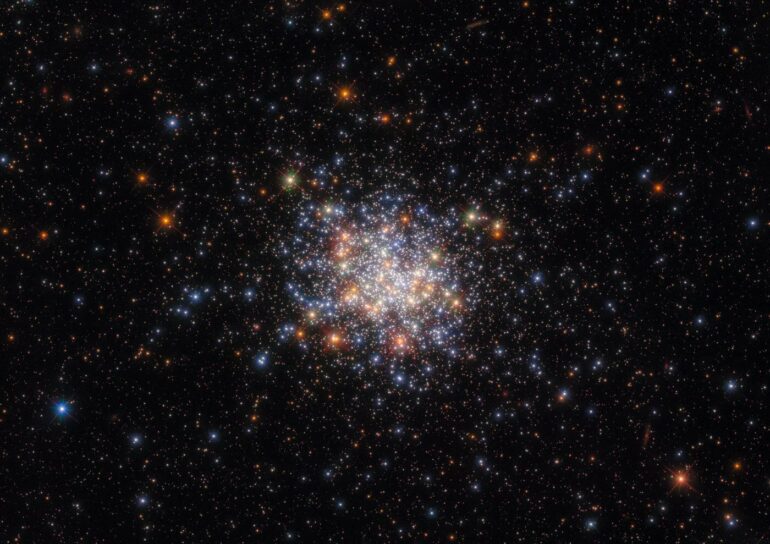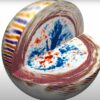Some humans try to look younger than they really are—stars do, too. This is reported by an international team of astronomers in a paper just published in Nature Astronomy.
They propose that stars in stellar clusters gain their mass in two different ways: via “normal” disk accretion, leading to rapid rotation and contributing to the red main sequence, or by mergers of binary stars, leading to slowly rotating stars that appear bluer and therefore younger.
It all began with probably the most famous diagram in astronomy, the Hertzsprung-Russell diagram. Created independently by the two astronomers Eijnar Hertzsprung and Henry Norris Russell more than a century ago, this diagram orders the stars by how bright they are and what color they have. Many of the things we know about stars and their evolution comes from studying how stars group together in this diagram. Our sun, for example, is still on the so-called “main sequence,” where most stars are.
Some stars, however, are located at strange positions in this diagram. For a long time, it was difficult to clearly distinguish different groups, as conventional telescopes are not precise enough. Recent Hubble Space Telescope observations, however, have revealed that the main sequences of young open star clusters are composed of several discrete components. In particular, the data for the NGC 1755, an open star cluster in the Large Magellanic Cloud with an age of some 60 million years, showed many puzzling features, such as a double main sequence.
“We believe that the stars in star clusters were all born at the same time out of the same gas cloud,” explains Chen Wang, who received her Ph.D. from the University of Bonn and recently became a postdoc at MPA and is lead author of the study now published in Nature Astronomy. “They should be the same age and have the same chemical composition. But if this is true, then how can there be a whole second sequence of stars that are bluer?”
This strange feature left astronomers puzzled; many even ignored this feature, as it was hard to come up with an explanation. However, with her experience as a theoretical astrophysicist, Chen combined two hints to propose an origin for these blue main sequence stars.
First, using computer simulations she showed that the blue stars can be explained if they rotate more slowly than the other cluster stars. Second, recent models of star mergers showed that the merged stars become highly magnetic and spin very slowly. Chen combined these two ideas and proposed that the blue stars are in fact very slowly rotating stars resulting from stellar mergers.
“The lives of stars in binary systems can be very complicated and different from single stars,” she says. “With our computer simulations we can study the impact of stellar mergers on the colors and luminosity of stars and simulate the features in the Hertzsprung-Russell diagram.”
A binary merger creates a star that is more massive than either of its progenitor stars, with a core hydrogen content higher than that of an equally old single star of the same mass. Thus, merger products may have the same age as all other cluster stars, but appear younger in the color-magnitude diagram, signified by their bluer color. Moreover, the mass distribution of blue and red main sequence stars is different, which again can be explained naturally by the merger origin.
“The merger hypothesis put forward by Chen as an explanation for the blue main sequence stars is very tempting, as it provides a logical way to combine different puzzles,” says Selma de Mink, director and head of the stellar astronomy group at MPA. It would mean that a significant fraction of stars melt together with a companion before their lives have even fully begun. If Chen is right, and she may well be, then this sheds new light on many questions how stars form, about why they sometimes rotate fast and sometimes slow, why some have magnetic fields.
“In the paper in Nature Astronomy, we show that it can be inferred from data from star clusters that stars can form in two different ways: by gas accretion (as has always been thought) or by stellar merger (this is new and involves about 30 percent of all stars),” says Prof. Dr. Norbert Langer of the Argelander Institute for Astronomy at the University of Bonn and the Max Planck Institute for Radio Astronomy in Bonn. “This sheds new light on the initial mass function of stars as well as on the bi-modal distribution of their spins and their magnetic fields.”
Thus, more than a century after Hertzsprung and Russell made their famous diagram, the explanation for the mysterious puzzle of the blue sequence may finally have been found. But of course, as with any hypothesis, this will need further tests.
More information:
Chen Wang et al, Stellar mergers as the origin of the blue main-sequence band in young star clusters, Nature Astronomy (2022). DOI: 10.1038/s41550-021-01597-5
Provided by
University of Bonn
Citation:
A new spin on the blue stellar sequence (2022, February 25)



